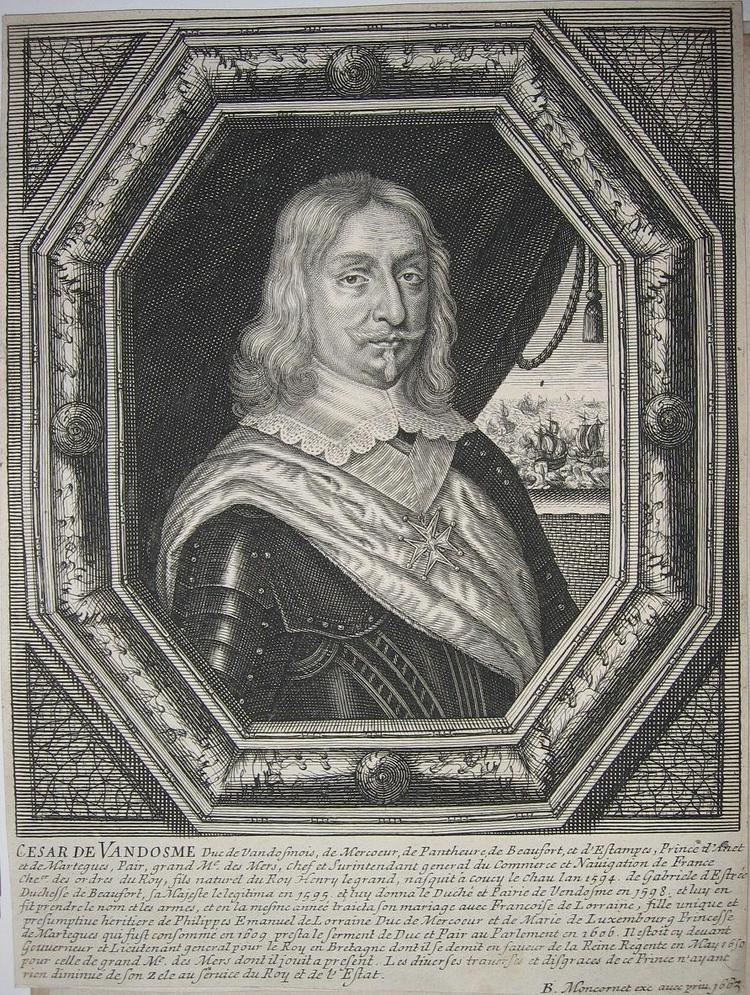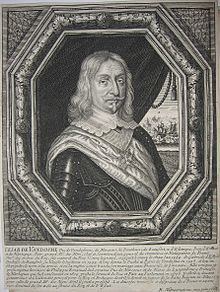Mother Gabrielle d\'Estrees | Name Cesar, of Role Duke of Etampes | |
 | ||
IssueDetail Louis, Duke of VendomeFrancois, Duke of BeaufortElisabeth, Duchess of Nemours Spouse Francoise de Lorraine, Duchess of Vendome (m. 1609–1665) Children Francois de Vendome, Duc de Beaufort, Elisabeth de Bourbon, Louis, Duke of Vendome Parents Gabrielle d\'Estrees, Henry IV of France Grandchildren Louis Joseph, Duke of Vendome Similar People Henry IV of France, Francois de Vendome, Gabrielle d\'Estrees, Francoise de Lorraine, Louis Joseph - Duke of V | ||
César de Bourbon, Légitimé de France (3 June 1594 – 22 October 1665) was the son of Henry IV of France and his mistress Gabrielle d'Estrées, and founder of the House of Bourbon-Vendome. He held the titles of 1st Duke of Vendôme, 2nd Duke of Beaufort and 2nd Duke of Étampes, but is also simply known as César de Vendôme. Through his daughter, Élisabeth de Bourbon, César was a great-great-great-grandfather of Louis XV of France, merging thereafter to the French royal line. César de Bourbon is also an ancestor of Juan Carlos I of Spain, of Albert II, King of the Belgians, of Henri, Grand Duke of Luxembourg, and of Vittorio Emanuele, Prince of Naples, a pretender to the Italian throne.
Contents
Biography
Born at the Château de Coucy in the Picardy region of France; his parents had started their affair in 1591 and César had been the couple's first child. He was legitimised in 1595, and was created the first Duke of Vendôme by his father in 1598. The Duchy of Vendôme had been owned by the Bourbon dynasty since 1393, at that point being a County then being raised by Louis XII of France to a Duchy. In the same year, he was engaged to Françoise de Lorraine (1592–1669), "...one of the richest heiresses in France".

In 1598, César was created Duke of Vendome in his own right. One year later he also inherited the titles of Duke of Beaufort and Duke of Étampes upon the death of his mother, who died as a result of a miscarriage in Paris.
His father, King Henry IV, was grief-stricken, especially given the widely held rumor that Gabrielle had been poisoned. He wore black in mourning, something no previous French monarch had done before. He gave her the funeral of a Queen; her coffin was transported amidst a procession of princes, princesses, and nobles to the Saint Denis Basilica for a requiem Mass. Known in French history and song as La Belle Gabrielle, she was interred at Abbaye Notre-Dame-la-Royale de Maubuisson, Saint-Ouen-l'Aumône (Val-d'Oise, Île-de-France).
He was his father's first son but due to his illegitimacy, was not allowed to inherit the throne; his half brother, the future Louis XIII of France was born in September 1601 much to the joy of the king.
On 16 July 1608, at the Château de Fontainebleau, he married Françoise de Lorraine (d. 1669), the wealthy heiress of Philippe Emmanuel, Duke of Mercœur. Françoise was the legal heir to the large and separate duchies of Mercœur and Penthièvre. Because Vendôme was the king's son, their marriage was celebrated with a big festival including a ball (featuring a pavane registered in André Danican Philidor's "Recueil de plusieurs airs par Philidor L'Aisné" that became known to a wider audience through the interpretation of "Le Concert des nations" under the direction of Jordi Savall) and its own Ballet de cour, the first one for Louis XIII to dance (The dauphin's dance was very good, so that within the next year it was followed by a "Ballet de M. le Dauphin dansé le 8 mars", the first appearances of the future king that brought forth Louis's great talent for dancing). The Duke of Vendôme fulfilled his marital duties, but he was famous for his numerous homosexual affairs. Some of them are reported in Tallement des Réaux's Historiettes.
César was involved in many noble intrigues during the reign of his half-brother Louis XIII of France. Implicated in the conspiracy of Chalais against Cardinal Richelieu, he and his brother Alexandre, the Chevalier de Vendôme, were imprisoned in the Château de Vincennes in 1626. He was released in 1630 and exiled to Holland.
In 1632, he returned to France but was soon accused of plotting the death of Richelieu and was exiled again, this time to England. He did not return until 1642. Soon after his return he took part in the cabale des Importants against Cardinal Mazarin, together with his second son François - this led to yet another exile, till 1650. The marriage of his son Louis to Laura Mancini brought about his reconciliation with Mazarin, and he supported Anne of Austria throughout the Fronde.
He reconciled with his half brother in December 1642, a year before his death and the beginning of the reign of his nephew Louis XIV. The reconciliation occurred after the death of Richelieu.
César led the royal troops against the rebels in Burgundy, of which he was appointed governor in 1650; appointed Grand Admiral of France in 1651 he helped to capture the insurgent stronghold of Bordeaux in July 1653. Joining French forces in the ongoing war with Spain, he defeated a Spanish fleet off Barcelona in 1655.
Early in 1665 the Duke of Vendôme was created the Grand Master of Navigation. He died later that year on 22 October 1665 in Paris and was buried in the chapel of Saint-Georges at the Château of Vendôme.
